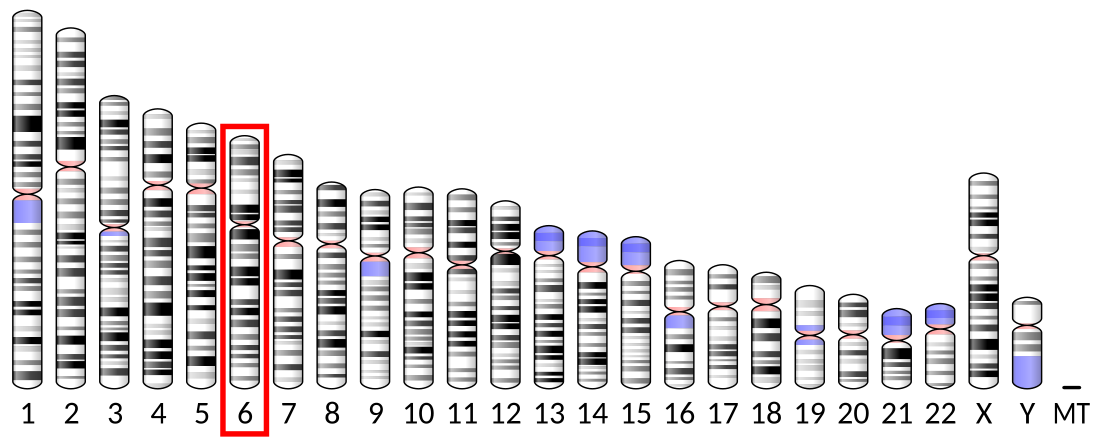Top Qs
Timeline
Chat
Perspective
C6orf136
Protein-coding gene in the species Homo sapiens From Wikipedia, the free encyclopedia
Remove ads
C6orf136 (Chromosome 6 Open Reading Frame 136) is a protein in humans (Homo sapiens) encoded by the C6orf136 gene. The gene is conserved in mammals, mollusks, as well some porifera.[5] While the function of the gene is currently unknown, C6orf136 has been shown to be hypermethylated in response to FOXM1 expression in Head Neck Squamous Cell Carcinoma (HNSCC) tissue cells.[6] Additionally, elevated expression of C6orf136 has been associated with improved survival rates in patients with bladder cancer.[7] C6orf136 has three known isoforms.
This article may have too many section headers. (December 2020) |
Remove ads
Gene
Background
C6orf136, also known as DADB-129D20.1, MGC15854, LOC221545, and OTTHUMP00000214979. The gene is a poorly characterized protein coding gene in need of further research. The C6orf136 gene can be accessed on NCBI with accession number NM_001109938.3.
Location
C6orf136 is located on the short arm of chromosome 6 (6p21.33), starting at base pair (bp) 30,647,133 and ending at bp 30,653,207. This gene spans 6,074 bit/s on the plus (+) strand and contains a total of 6 exons.[8]
Gene Neighborhood
Genes in the neighborhood of C6orf136 are the following: ATAT1, PPP1R10, DHX16, PPP1R18, MDC1, MRPS18B, TUBB, and FLOT1.[8]
Remove ads
mRNA
C6orf136 has a total of 3 different isoforms. Isoform 1 is the base version of C6orf136 that encodes for the 315 amino acid protein. Isoform 3 uses an alternate in-frame splice site in the 5' coding region when compared to isoform 1, resulting in isoform 3 being longer than isoform 1. Alternatively, isoform 2 lacks an alternate in-frame exon in the 5' coding region when compared to isoform 1, resulting an isoform 2 being shorter than isoform 1
Remove ads
Protein
Summarize
Perspective
General Properties
The sequence for the C6orf136 isoform 1 gene per NCBI is as follows:[9]
MYQPSRGAARRLGPCLRAYQARPQDQLYPGTLPFPPLWPHSTTTTSPSSPLFWSPLPPRLPTQRLPQVPP 70 LPLPQIQALSSAWVVLPPGKGEEGPGPELHSGCLDGLRSLFEGPPCPYPGAWIPFQVPGTAHPSPATPSG 140 DPSMEEHLSVMYERLRQELPKLFLQSHDYSLYSLDVEFINEILNIRTKGRTWYILSLTLCRFLAWNYFAH 210 LRLEVLQLTRHPENWTLQARWRLVGLPVHLLFLRFYKRDKDEHYRTYDAYSTFYLNSSGLICRHRLDKLM 280 PSHSPPTPVKKLLVGALVALGLSEPEPDLNLCSKP 315
The bolded region in this sequence indicates a domain of unknown function (DUF2358) found in all three isoforms of C6orf136.
The C6orf136 protein has a molecular weight of 35.8 kD and an isoelectric point of 8.99, making the protein slightly basic and physiological pH.
Domains
DUF2358 is a domain of unknown function found within the C6orf136 protein from aa149 to aa274.[10] This domain is highly conserved in the C-terminus region and is evolutionarily conserved from plants to humans.[11] Additionally, a proline rich domain was also predicted from aa29 to aa142 of the human C6orf136 protein.[10]

Structure
Secondary Structure
The conserved DUF2358 domain of C6orf136 contains an equal mix of alpha helices and beta sheets interspersed in that region.[12][13][14] The N-terminus of the protein contained primarily alpha helices, but was poorly conserved across species.
Tertiary Structure
The tertiary structure illustrates a primarily alpha helices in the N-terminus of the protein loosely wound up, followed by a densely packed and folded region correlating to the DUF2358 domain with a mix of alpha helices and beta sheets as determined by I-TASSER.[15][16][17]
Regulation
Summarize
Perspective
Gene Regulation
Promotor
C6orf136 has 5 predicted promotor regions. The GXP_6051617 promotor had the largest number of transcripts and CAGE tags. It's located on the plus (+) strand, starts at position 30646644, ends at position 30647460, and is 817 bp in length. It also has 12 total coding transcripts.[18]

Transcription Factor Binding Sites
The following table highlights the most likely transcription factors binding to the GXP_6051617 promotor for C6orf136.[18]
Expression Pattern
C6orf136 is expressed highly in the heart, intestine, brain, and kidney tissue.[8] According to AceView, it is well expressed at 1.3x the average gene expression.[19]
Transcription Regulation
Stem Loop Prediction
The 3’ UTR sequence had a total of 7 step loops with a single site for potential miRNA binding. In contrast, the 5’ UTR had only 2 stem loops and contained no other notable regions.[20]
miRNA Targeting
TargetScan indicated a single has-miRNA-585-3p miRNA binding site in the 3' UTR, shown to be associated with tumor-suppressing properties with respect to gastric cancer.[21][22]
Protein Regulation
Subcellular Localization
C6orf136 is predicted to be localized primarily in the nucleus in Homo sapiens, but is predicted to be primarily expressed in the mitochondria in other species.[23]
Post-Translational Modification
The C6orf136 gene has 8 predicted kinase-specific phosphorylation sites at positions 5, 28, 137, 139, 191, 256, 261, and 303, where 4 of the phosphorylation sites are serines, 3 sites are threonines, and 1 is a tryptophan.[24] Additionally, the protein also has a single predicted SUMOylation site at position 247 on a lysine with a p-value of 0.063.[25]
Remove ads
Homology
Summarize
Perspective
Paralogs

No paralogs of C6orf136 have been detected in the human genome.
Orthologs
Below is a table of selected orthologs of the C6orf136 gene, including closely and distantly related orthologs.[26] C6orf136 has evolved moderately and evenly over time with a rate faster than Cytochrome C but slower than Fibrinogen Alpha.
Remove ads
Function
Remove ads
References
Wikiwand - on
Seamless Wikipedia browsing. On steroids.
Remove ads




